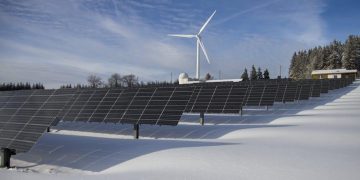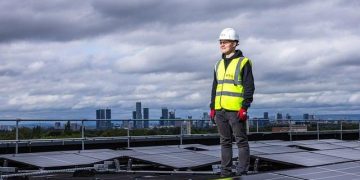In a world where energy bills seem to climb higher with each passing season and the call for sustainable living grows louder, homeowners are increasingly turning their eyes skyward for a solution. Solar power, once a futuristic dream, has swiftly become a tangible reality for many households. This shift is not just a trend; it’s a revolution powered by the sun. As panels glisten on rooftops and the hum of energy independence fills the air, we delve into the top ten reasons why this renewable energy source is capturing the hearts and minds of homeowners everywhere. Whether driven by economic, environmental, or technological motivations, the move to solar power is illuminating new possibilities for a brighter, cleaner future. Join us as we explore the compelling factors behind this sunlit transition.
Environmental Impact and Sustainability Benefits
Switching to solar power not only reduces energy bills but also contributes positively to the environment. By utilizing the sun’s energy, homeowners significantly cut down on carbon emissions, making solar energy a cleaner alternative to fossil fuels. This shift helps in reducing the carbon footprint, which is crucial in combating climate change. Additionally, solar power requires less water compared to conventional electricity production, conserving an essential natural resource.
- Reduction in Carbon Emissions: Solar panels produce energy without releasing harmful pollutants, helping to decrease air pollution.
- Conservation of Water: Unlike traditional power generation methods, solar energy systems do not rely on water to produce electricity.
- Promotion of Renewable Energy: Investing in solar power supports the transition to renewable energy sources, fostering a more sustainable future.
Cost Savings and Financial Incentives
One of the most compelling reasons homeowners are embracing solar power is the potential for significant cost savings. With the ability to generate your own electricity, you can drastically reduce, or even eliminate, your monthly utility bills. This is especially advantageous in regions where electricity rates are high and continue to rise. Over time, the savings can be substantial, effectively offsetting the initial investment in solar panels.
- Tax Credits and Rebates: Many governments offer tax incentives and rebates to encourage the adoption of solar energy. These can significantly lower the cost of installation.
- Net Metering: Some utility companies offer net metering, allowing you to sell excess energy back to the grid, providing an additional financial benefit.
- Increase in Property Value: Homes equipped with solar panels often see an increase in property value, offering a long-term financial advantage.
With these financial incentives, switching to solar power is not only an environmentally conscious decision but also a savvy financial strategy for homeowners looking to maximize their savings and investments.

Technological Advancements in Solar Panels
Over the past decade, solar panel technology has undergone remarkable transformations, making it more appealing to homeowners. Efficiency has soared, with new panels capable of converting sunlight into energy at unprecedented rates. This improvement is largely due to innovations like bifacial solar panels, which capture sunlight on both sides, and perovskite cells, offering a flexible and cost-effective alternative to traditional silicon cells. These advancements mean that even homes with limited roof space can generate substantial power, bringing solar energy within reach for a wider audience.
- Durability has also seen significant improvements, with modern panels boasting longer lifespans and better resistance to weather conditions.
- The integration of smart technology allows homeowners to monitor and optimize their energy use in real time, maximizing efficiency and savings.
- Aesthetic designs have evolved, with sleeker, more attractive options available, such as solar roof tiles that blend seamlessly with traditional roofing materials.
These technological leaps are not just about better energy conversion; they’re about making solar power more accessible and attractive to everyday homeowners.

Steps to Make the Transition to Solar Energy
Embarking on the journey to solar energy can seem daunting, but with a clear roadmap, it becomes an empowering transition. First, assess your home’s energy needs to understand how much solar power you’ll require. Consult with a professional to conduct an energy audit and determine the most suitable system size for your consumption. Next, research local incentives and rebates that could significantly offset initial costs. Many regions offer tax credits, rebates, and even net metering options that make solar more affordable. It’s also essential to evaluate your roof’s condition and orientation to ensure it can support solar panels effectively.
Once you’ve gathered this information, reach out to reputable solar installation companies. Request quotes, compare offers, and check customer reviews to find a reliable partner. When you’re ready to proceed, work closely with your chosen installer to obtain necessary permits and schedule the installation. The installation process itself is usually straightforward, taking just a few days. after the system is in place, monitor your energy production and savings to ensure everything is functioning optimally. With each sunlit day, you’ll enjoy the dual benefits of reducing your carbon footprint and lowering your energy bills.
The Way Forward
As we draw the curtains on our exploration of why so many homeowners are making the sunny switch to solar power, it’s clear that this renewable energy source is more than just a fleeting trend. Whether driven by the promise of financial savings, the allure of energy independence, or the desire to tread more lightly on our planet, solar power offers a bright beacon of opportunity. As the sun continues its daily arc across the sky, perhaps it’s time to consider how its boundless energy might illuminate not just our homes, but also the future we wish to create. The reasons to embrace solar power are as varied as they are compelling, inviting each of us to envision a tomorrow where sustainability and innovation go hand in hand.

































